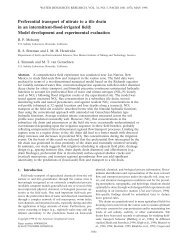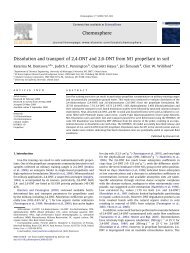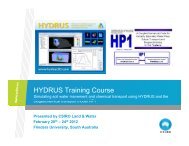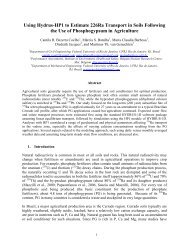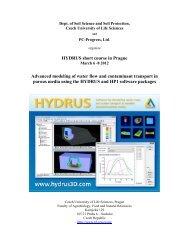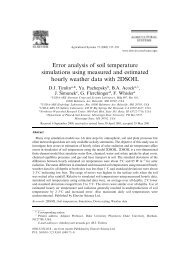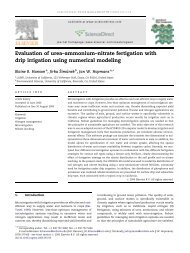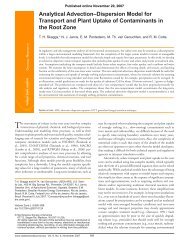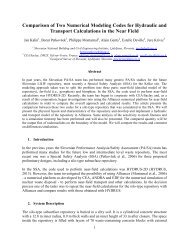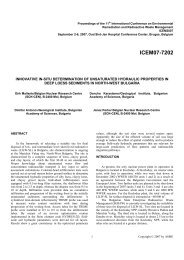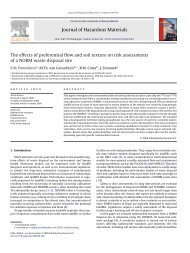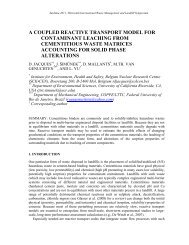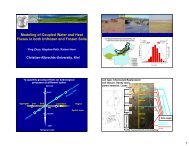Full Text (PDF) - Soil Science Society of America
Full Text (PDF) - Soil Science Society of America
Full Text (PDF) - Soil Science Society of America
- No tags were found...
You also want an ePaper? Increase the reach of your titles
YUMPU automatically turns print PDFs into web optimized ePapers that Google loves.
www.vadosezonejournal.org437Reproduced from Vadose Zone Journal. Published by <strong>Soil</strong> <strong>Science</strong> <strong>Society</strong> <strong>of</strong> <strong>America</strong>. All copyrights reserved.Table 5. Initial and boundary liquid-phase concentrations andother geochemistry parameters.ParameterUnitsInitial heapinterstitial waterRecharge waterCa 12 mmol L 21 20 0.5Mg 12 mmol L 21 0.225 0.025Na 11 mmol L 21 5 0.05K 11 mmol L 21 0.05 0.05Alkalinity mmol L 21 37.5 0.05SO4 22 mmol L 21 3 0.025Cl 21 mmol L 21 2 0.05As(III) Sips mmol L 21 (mg L 21 ) 4.731 (354) 0IsothermAs(III) Keren mmol L 21 (mg L 21 ) 3.330 (250) 0IsothermAs(V) mmol L 21 (mg L 21 ) 0 (0) 0 (0)pH 8.76pO 2 atm 0 0.2Tracer 0 1.0be representative <strong>of</strong> an average, carbonate-hosted,sulfide-bearing ore. In particular, the 20% by weightcarbonate and 2.5% by weight pyrite are characteristics<strong>of</strong> a carbonate-hosted ore body. The inclusion <strong>of</strong> As inthe pyrite mass is meant to represent the mineral origin<strong>of</strong> As that has been reported in several heap facilities.The gas transport boundary conditions for all threeexamples are modeled as constant partial pressures inthe atmosphere, with the top <strong>of</strong> the heap pr<strong>of</strong>ilerepresented with values <strong>of</strong> 0.2 atm for O 2 and 10 -3.5 atmfor CO 2 and the bottom <strong>of</strong> the pr<strong>of</strong>ile set to 0 atm forboth gases. Thus, gas transport into the heap pr<strong>of</strong>ile islimited to the top surface.The geographical region encompassing the CarlinTrend is characterized by an arid climate with lowannual precipitation with correspondingly high evapotranspirationrates that can be several times larger thanthe average annual precipitation. However, the largerange in heap facility site elevation complicates thisbroad categorization, with the possibility <strong>of</strong> significantsnowmelt recharge occurring at high-elevation sites inthe winter months (Kampf et al., 2002). Controlling rechargeflux into heap facilities is a key component <strong>of</strong>long-term management <strong>of</strong> both the remaining mineralresource in the facility, and in ensuring effective environmentalstewardship.Mine operations are required to close heap-leachfacilities such that a number <strong>of</strong> environmental regulationsare met. This is typically accomplished through aregimen <strong>of</strong> rinsing leachate fluids from the heap withfresh water and establishing a long-term fluids managementplan to control water discharge for the facility. TheTable 6. Initial conditions for mineral- and sorbed-phase concentrations.costs associated with the fluids management plan are <strong>of</strong>such magnitude that designing an effective closure planthat includes understanding the impacts <strong>of</strong> engineeringsolutions to limit the precipitation flux into the top <strong>of</strong> theheap facility on the chemistry <strong>of</strong> the discharge water iskey to minimizing costs and maximizing the effectiveness<strong>of</strong> the management plan. The three examples presentedillustrate the long-term effects on As concentration andmass flux from precipitation and gas fluxes at the heapfacility surface.Example 1: Uncovered Heap-Leach FacilityThe first example represents an uncovered heap facilitywith a relatively large steady-state recharge fluxrate <strong>of</strong> 300 mm yr 21 that is representative <strong>of</strong> a highelevationenvironment with significant snowmelt recharge.The calculated steady-state water content is0.097, which corresponds to a pore volume <strong>of</strong> water <strong>of</strong>291 cm 3 and a time to infiltrate a single pore volume <strong>of</strong>9.7 yr (Fig. 2h). The initial pH <strong>of</strong> the pr<strong>of</strong>ile is set at 8.7 torepresent a heap that is recovering from a period <strong>of</strong> goldproduction wherein the pH is maintained at very highlevels (in excess <strong>of</strong> pH 10) to prevent the loss <strong>of</strong> cyanide(Bartlett, 1992) (Fig. 2e). This pH rapidly decreases tolower pH values due to the influence <strong>of</strong> carbonate mineraldissolution, sulfide mineral dissolution, and gypsumprecipitation reactions. As arsenian pyrite is dissolved(Fig. 2b), the acid generated is buffered through thedissolution <strong>of</strong> calcite (Fig. 2a). The dissolution <strong>of</strong> arsenianpyrite is limited by the rate <strong>of</strong> oxygen transportthrough the relationship given in Eq. [20]. Oxygen transport(Fig. 2g) in turn is limited by the effective dispersioncoefficient for oxygen. The linear pr<strong>of</strong>iles shown inFig. 2g are indicative <strong>of</strong> an arsenian pyrite oxidation ratethat is in excess <strong>of</strong> the oxygen transport rate. Sulfate isproduced through the dissolution <strong>of</strong> arsenian pyrite(Fig. 2f) and is precipitated as gypsum (Fig. 2c). Theaqueous iron generated from arsenian pyrite dissolutionis precipitated as iron hydroxide through the kineticrelationship in Eq. [21] (Fig. 2d).Arsenic is initially distributed as As(III) between theaqueous and sorbed phases in a proportion determinedby the Sips-type isotherm, (Eq. [23]), and for the parametervalues given in Table 7 for an initial pH <strong>of</strong> 8.76(Fig. 2i). The speciation <strong>of</strong> As from As(III) to As(V)occurs along a moving redox front that is coincident withthe oxygen transport and arsenian pyrite oxidationfronts. In Fig. 2i and 2j, the presence <strong>of</strong> the oxidationParameter Unit Keren isotherm Sips isothermCalcite mol kg 21 (g kg 21 ) 2 (200) 2 (200)Gypsum mol kg 21 (g kg 21 ) 0.005 (0.68) 0.005 (0.68)Pyrite mol kg 21 (g kg 21 ) 0.208 (25) 0.208 (25)Fe(OH) 3 mol kg 21 (g kg 21 ) 0 0Pyrite surface area m 2 g 21 7.5 3 10 28 7.5 3 10 28Arsenian pyrite fraction 0.00075 0.00075Sorbed As(III) mmol kg 21 (mg kg 21 ) 1666.663 (124.8691) 1666.662 (124.8689)Sorbed As(V) mmol kg 21 (mg kg 21 ) 0 (0) 0 (0)Total As(III) mass(aqueous and sorbed)mmol kg 21 (mg kg 21 ) 1666.667 (124.8693) 1666.667 (124.8693)



